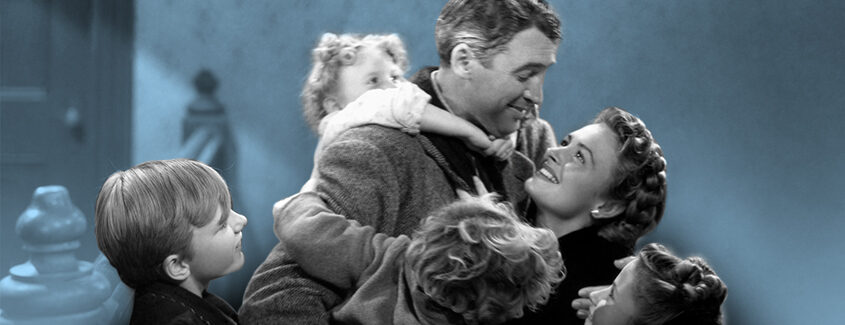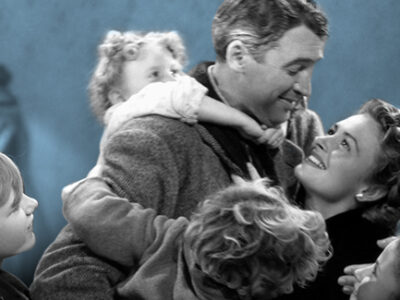
Editor’s note: This article first appeared at The American Spectator.
Asked in an interview recently to name my favorite Christmas movie, I went through the usual routine of naming several candidates — new and old, mostly black and white — before inevitably getting to the point, the undeniable, the obvious: Frank Capra’s 1946 masterpiece, It’s a Wonderful Life.
“Look,” I fessed up, “I know it might seem trite to say this, but can’t we all just be honest and concede that It’s a Wonderful Life is not only the greatest Christmas movie ever made but the greatest movie ever made period? There is no debating this. I cry like a little girl every time I watch it.”
Many guys have told me the same. Yes, guys — the males of the species. These are guys who otherwise, like me, might pick The Godfather (I or II), and identify with Michael Corleone or Marlon Brando’s character, or perhaps might point to Hugh Jackman’s “John Valjean” in the terrific 2012 version of Les Miserables, or a Humphrey Bogart or John Wayne role. To quote my colleague David Ayers, writing last year after visiting Jimmy Stewart’s hometown museum: “Once again this Christmas season, countless Americans sat down to watch Frank Capra’s Christmas classic, It’s a Wonderful Life, starring the great Jimmy Stewart. I’ve seen the movie plenty of times. So why did it leave me crying again this year?” (Bruce Bawer has said the same in these pages.)
Yes, why? It has that effect, unavoidably.
Real Artistry
When asked to name a favorite film, I suppose many are tempted to invoke some faux-intellectual, foreign, Frenchy, avant-garde drivel. But for a hick like me from Butler, Pennsylvania, there are no such airs. (Incidentally, in part because I’m from Western Pennsylvania, The Deer Hunter is also a favorite of mine.)
Many a snob would deny Capra’s masterpiece its rightful place in the film pantheon, akin to sneering at the beautiful work of a Norman Rockwell while waxing silly over some bizarro hunk of nightmarish slop hung on a wall in some museum of modern “art.” But that’s their problem. Norman Rockwell produced real artistry, as did Frank Capra.
To repeat, note that I’ve gone so far as to assert that Capra’s It’s a Wonderful Life is not only the best Christmas movie ever, but the best movie ever. Quite a claim, eh?
Well, whilst recently reading Capra’s memoirs, I was pleasantly surprised to see that Capra himself said the same. Before quoting him, let me say that Frank Capra (1897-1991) was not an arrogant man. Moreover, as for cynics who sneer at Capra’s work as sentimental, sappy, and overly idealistic, if they more carefully studied his films they would see that they included plenty of dark moments. That included Jimmy Stewart’s George Bailey — the cheerful protagonist — hitting some very low dark-night-of-the-soul moments. The pivotal moment for George in It’s a Wonderful Life comes while standing atop a bridge ready to plunge into the freezing water to commit suicide (not exactly a Rockwell portrait).
So, what did Frank Capra himself say about It’s a Wonderful Life?
“I thought it was the greatest film I had ever made,” wrote Capra in his 1971 autobiography. “Better yet, I thought it was the greatest film anybody ever made” (emphasis original).
Yes, that anyone ever made. Capra thought so. This was a man who also made masterpieces such as Meet John Doe (Barbara Stanwyck, Gary Cooper, and William Brennan), Mr. Smith Goes to Washington (Jimmy Stewart, Jean Arthur, and Claude Rains), It Happened One Night (Clark Gable and Claudette Colbert), You Can’t Take It With You (Lionel Barrymore, Jimmy Stewart, Jean Arthur, and Edward Arnold), Mr. Deeds Goes to Town (Gary Cooper and Jean Arthur), and so many more.
“It wasn’t made for the oh-so-bored critics, or the oh-so-jaded literati,” continued Capra.
No, it wasn’t. Those types, the Manhattan crowd, predictably panned it.
‘No Man Is a Failure’
The effete elitist Bosley Crowther of the New York Times dismissed Capra’s film as a “figment of simple Polyanna platitudes.” (Crowther, conversely, swooned over the egregious pro-Stalin flick, Mission to Moscow.) Over at the New Yorker, the highbrows snickered at Capra’s “baby talk,” and particularly found the film’s guardian-angel stuff to be, well, just unbearably childish: “Henry Travers [who played Clarence the guardian angel], God help him, has the job of portraying Mr. Stewart’s guardian angel.”
Oh, the horrors! Poor Travers! Guardian angels? Huh!
The New Republic, the bible of the American Left, sneered at Capra’s work: “Hollywood’s Horatio Alger fights with more cinematic know-how and zeal than any other director to convince movie audiences that American life is exactly like the Saturday Evening Post covers of Norman Rockwell.”
Interestingly, the New Republic had no problem with Soviet life. “I am a patriot for Russia; the Future is there,” glowed TNR’s Lincoln Steffens. “Russia will win out and it will save the world.”
Leave it to the New Republic to defend Alger Hiss and Stalin’s USSR but not Norman Rockwell and Frank Capra’s It’s a Wonderful Life.
Do enlighten us more, comrades!
As for Frank Capra, who dealt head-on with Hollywood’s communist left, he was undeterred by these ideological scolds. His film was not for those people. Capra explained who it was for: “It was my kind of film for my kind of people; the motion picture I had wanted to make since I first peered into a movie camera’s eyepiece in that San Francisco Jewish gymnasium.”
Capra’s people were those who had come to America like him as a poor, penniless immigrant from Sicily, with no chance for the Ivy League education bequeathed to bluebloods like Bosley Crowther and the blathering Bolshies at the New Republic.
To Capra, It’s a Wonderful Life was “A film to tell the weary, the disheartened, and disillusioned; the wino, the junkie, the prostitute; those behind prison walls and those behind the Iron Curtains, that no man is a failure!” (emphasis original)
Capra’s cry — that line, “no man is a failure“— chokes me up now as I picture in my mind the scene when Clarence the guardian angel says precisely that to George Bailey.
Of course, the story reaches its climax when George Bailey gets that message. A revived Bailey dashes through snowy Bedford Falls with new life, shouting “Merry Christmas!” to all. I’m always struck by that image because I grew up seeing it at Christmas time in Western Pennsylvania towns like Emporium, St. Mary’s, Brockway, Bedford (yes, Bedford), and even Jimmy Stewart’s hometown of Indiana, Pennsylvania, where Capra could have shot that scene in a December with no need for snow machines.
No person need be a failure. As Capra further explained, he wanted “To show those born slow of foot or slow of mind, those oldest sisters condemned to spinsterhood, and those oldest sons condemned to unschooled toil, that each man’s life touches so many other lives [emphasis original]. And that if he isn’t around it would leave an awful hole.”
Capra went on: “A film that expressed its love for the homeless and the loveless; for her whose cross is heavy and him whose touch is ashes; for the Magdalenes stoned by hypocrites and the afflicted Lazarus with only dogs to lick their sores. I wanted to shout it to the abandoned grandfathers staring vacantly in nursing homes…. I wanted to shout, ‘You are the salt of the earth. And It’s a Wonderful Life is my memorial to you!’”
He wanted them to know, “No man is poor who has one friend.”
That’s yet another scene from the film that chokes me up every time. And if that doesn’t touch your heart, Mr. Crowther, Mr. New Republic, Mr. New Yorker, Mr. Whoever, then I feel bad for you.
A great message from a great movie. Remember it always. Merry Christmas, everyone.




